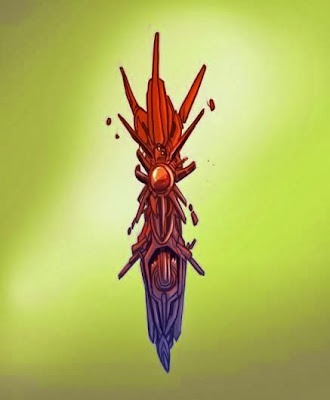Today's FATE SF post is our contribution to the Obscure Simulations Roundup, a community blog hop dedicated to forgotten or under-appreciated RPGs. As regular readers of FATE SF know, I have a forthcoming generation ship RPG of my own called
Project Generations. So it shouldn't be a big surprise that my OSR post is an appreciation for Jim Ward's original generation ship SF RPG,
Metamorphosis Alpha (TSR, 1976
).
Metamorphosis Alpha isn't the most obscure or forgotten RPG. After all, it
was the first SF RPG published. It's not even out-of-print. You can buy
Metamorphosis Alpha in PDF
here, or pick up a hard copy from Lulu
here.
I'm writing about
Metamorphosis Alpha today because it has a special place in my heart. It was one of the first RPGs I purchased, shortly after the first edition of
Traveller and around the same time that I picked up Whitebox
D&D.
One of the first SF novels I read as a kid was Robert A. Heinlein's
Orphans of the Sky. It was an SF novel about a population of humans and mutants (you can see the mutant Joe-Jim standing in the picture above) living on a slower-than-light interstellar generation ship many generations after the ship's launch. Over that time, successive generations had 1) forgotten that they were on a star ship, and 2) had lost the skills to pilot and maintain their vessel. They were essentially lost in space, facing eventual doom unless a group of heroes rediscovered that they were on a ship that had a destination in mind. A small band of humans and mutants - two communities usually at each others' throats - made this discovery and set about to bring things to right.
Generation ship stories often involve
an epistemological break from ignorance, to (re)discovery, to setting things right. Such a discovery is common in SF stories but particularly important in traditional generation ship narratives. For example, you see it in the very title of the classic
Star Trek episode about
the generation ship Yonada,
"For the World is Hollow and I Have Touched The Sky".
While scientific and cosmological discoveries made by characters in the Cthulhu Mythos stories are ultimately disempowering, underscoring the futility of human effort and of irrelevance of the human scale, discoveries made in generation ship stories are ultimately liberating and empowering. People learn that the world is not what it seems, that it needs to be fixed or improved in some way, and that the means to fix the generation ship and set its course right are within the characters' reach - if they know where to look, and what to make of things! The characters may have to struggle or sacrifice, but their efforts aren't ultimately in vain. That's hopeful, and a call to responsibility.
Of course, my encounter with the generation ship in
Orphans of the Sky was quickly followed by watching the early '70s SF generation ship TV series,
The Starlost. Ed Bryant and Harlan Ellison wrote the screenplay (and a novel,
"Phoenix Without Ashes") for this Canadian TV series, and Ellison quickly turned against his series very vocally, deriding laughable plots, implausible SF terms, and rotten dialogue. In 2011, "Phoenix Without Ashes" was also published by IDW as a graphic novel.
Oh well. I loved the show as a kid. The ship model was wonderful and there was some interesting tech on the ship, such as the the habitat hemispheres, the iris doors, the small cassettes and devices used to control access to different parts of the ship through the iris doors, the bounce tubes that helped people get around the non-habitat parts of the ship quickly, and of course the librarian AI.
Silent Running also comes to mind as a generation ship eco-narrative of the '70s - even if those ships weren't really going anywhere.
 |
| Silent Running (1972) |
They also had cute maintenance and gardening droids. Every generation ship needs
maintenance drones of some kind. Somebody needs to continue working and repairing things while the humans busy themselves with killing each other.
 |
| Silent Running |
So anyway, back to Metamorphosis Alpha. It's an extremely simple system by contemporary standards, but it does the job. There are six Abilities, rolled randomly using 3d6:
Radiation Resistance (pretty important, as the generation ship
Warden in the default setting was damaged by a cloud of interstellar radiation and is still contaminated with radiation),
Mental Resistance (defense against psionic mental attacks, as well as the intelligence skill that helps characters understand the ship's now ancient, mysterious, and often deadly tech),
Dexterity,
Strength,
Leadership Potential (only pure humans can attract followers; human and animal mutants don't even get this Ability), and
Constitution (determines how many d6 of hit dice you get, as well as your ability to survive poisoning). If after reading the Constitution bit you're saying "
Hello, Carcossa" you should be, although in
Metamorphosis Alpha you only roll the dice for hit points when you create your character - not every encounter.
If you are a pure human, you are pretty much done at this point. Take clothes and weapons typical of your community. If you are going to play a mutant human or mutant animal, you roll 1d4 to determine the number of physical mutations you get, and 1d4 for the number of mental mutations. You pick your mutations from the lists for each type. Then the GM gets to roll to determine randomly what physical and mental mutational defects you get; the GM rolls either once (if the player has 4 or less mutations) or twice (i.e., once on each list, if the PC has 5 or more mutations). Mutants get no equipment.
Then you are ready to play. The core mechanic is d20 based and there won't be huge surprises to people who have played other OSR d20 games.
The GM needs to have at least part of one level of the
Warden detailed before play begins. This is good as it enables sandbox play, but there's nothing to stop the GM from detailing as much of the ship upfront as they'd like to do. Like building a dungeon, this is a game in itself.
The book tells you what the general details of each deck of the ship should be, as well as the kinds of technologies found on the ship, and their relative complexity; PCs roll their Mental Resistance vs. an item's complexity in order to figure out if their character knows what to do with it and can handle it without risk of injury. There's guidance to help the GM build mutated animals, plants, and humans, as well as guidance for robots and androids (i.e., chemical life - essentially, replicants).
There's no experience system, so (all things being equal) characters will keep the abilities that they have until death or the end of the campaign. I think that's good, as it keeps play focused on exploration and problem-solving, and not on monster hunting and treasure seeking as ends in themselves. All the treasure in the world won't do you a bit of good if your ship burns up in an alien sun, crashes into an uninhabitable planet, or runs out of gas between the stars.
Here's a few campaign ideas for Metamorphosis Alpha:
Metamorphosis Moonbase Alpha: The sudden departure of Earth's rogue moon caused a disaster at home, and a very long, strange trip for the inhabitants of
Moonbase Alpha. The Alphans are used to sudden transitions. One moment, their moon is travelling along in the depths of interstellar space; a few days or weeks or months later, it is careening into another solar system entirely.
So imagine the Alphans' surprise when they receive an automated distress signal from a ship they are approaching. A signal in English. It's a vast ship. It's an Earth ship: the hull says:
"Warden." Moonbase Alpha's computer (there is only one!) has no record of any such launch. Was the vessel launched after the moon ripped itself out of Earth orbit?
A ship this big could have many things of value on board: replacement technology, hydroponic supplies and seeds, medicines, astrogational records, news from Earth - many things. The ship is crawling with radiation. It's too risky to send more than one Eagle to investigate. The Commander calls for volunteers.
[The GM
should secretly roll 1d6. That is how many days the Eagle crew will have to explore the
Warden before the moon begins to accelerate away from the
Warden forever.]
Return to Yonada: The
U.S.S. Enterprise is called back to the asteroid generation ship of Yonada. A civil war has broken out on the vessel, even as it has settled into a stable orbit around a habitable world. A restorationist cult called
The Most Devoted to the Oracle have declared that it is heresy to leave Yonada. They have tapped into the central computer of the ancient space ark, and have appropriated the medical secrets of the Fabrini (the Yonadan's distant ancestors who built the ship), unleashing a mutogenic viral plague which has wreaked havoc on the People of Yonada. Worse still, the High Priestess of the People, Natira, has gone missing. She must be rescued, as Natira is the Yonadan leader with the greatest interest in helping the People of Yonada complete their ancestors' long journey to colonize a new world.
Play a native Yonadan loyal to Natira, or a Federation officer! Find Yonada's rightful ruler! Defeat the cult and its mutant menace!
 |
| Yonada |
Ark of the Shunned Ones: A reconnaissance starship far beyond the borders of the
Humanspace Empire discovers an ancient generation ship: a vessel of the hideous and inimical Shunned Ones. The Ship's Telepath reports the presence of human minds on-board the generation ship, as well as the minds of a great many other alien races. The Shunned Ones' ship is in a terrible state of disrepair, leaking radiation and strange other-planar energies; it may not survive much longer. It would be desirable to rescue the humans on-board, and to explore this great vessel before its imminent demise. The Captain orders a team of scientists and marines to board the ship.
Beneath the Pyramid of the Sun: The great hexagonal Sun crosses the sky every day. Every day, your temple feeds it a live human heart, ensuring that it will return from the Underworld at the end of the night to bring the next day. Yet today, just before the sacrifice, a strange creature appeared from the Underworld beneath the temple, and stole the mid-day sacrifice. A group of brave warriors and priests must descend into the Underworld and find this monster.
"Chariots of the Gods?", anyone? Aztecs, mutants, and more on a generation ship with many different habitat compartments, each containing a different ancient human culture. (Check out Harry Harrison's
Captive Universe for even more inspiration!)
Also, be sure to check out
Brett Slocum's idea for a Paranoia-Metamorphosis Alpha mash-up over at
The Eye of Joyful Sitting Amongst Friends blog.
Finally, we leave you with a rather evocative piece from near the end of the Metamorphosis Alpha book. The artist is David Sutherland, who was not only responsible for the art in
Metamorphosis Alpha, but also
did many of the illustrations for
Empire of the Petal Throne.
 |
| Art by David Sutherland! |








































